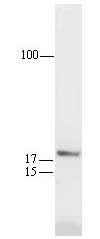Select a Size
About This Item
Product Name
Anti-p21WAF1 (Ab-1) Mouse mAb (EA10), liquid, clone EA10, Calbiochem®
biological source
mouse
antibody form
purified antibody
antibody product type
primary antibodies
clone
EA10, monoclonal
form
liquid
contains
≤0.1% sodium azide as preservative
species reactivity
human
should not react with
mouse, rat
manufacturer/tradename
Calbiochem®
storage condition
do not freeze
dilution
(Flow Cytometry (2 µg/mL)
Frozen Sections (5 µg/mL)
Immunoblotting (1-3 µg/mL)
Immunofluorescence (1-5 µg/mL)
Immunoprecipitation (2 µg/sample)
Paraffin Sections (5 µg/mL or use OP64F; heat pre-treatment required; and application references))
isotype
IgG1
shipped in
wet ice
storage temp.
2-8°C
target post-translational modification
unmodified
Quality Level
Gene Information
human ... CDKN1A(1026)
Analysis Note
Any cell line expressing wild-type p53 (e.g. Hs27 or U2OS treated with DNA-damaging agents) or skin or colon tissue
Application

Flow Cytometry (2 g/ml or use Cat. No. OP64F; see application references)
Frozen Sections (5 g/ml or use Cat. No. OP64F)
Immunoblotting (1-3 g/ml)
Immunofluorescence (1-5 g/ml or use Cat. No. OP64F)
Immunoprecipitation (2 g/sample)
Paraffin Sections (5 g/ml or use OP64F; heat pre-treatment required; see comments and application references)
Disclaimer
General description
Other Notes
Chen, Y.Q., et al. 1995. Int. J. Oncology7, 889.
Deng, C., et al. 1995. Cell82, 675.
El-Deiry, W.S., et al. 1995. Cancer Res.55, 2910.
Waldman, T., et al. 1995. Cancer Res.55, 5187.
Elbendary, A., et al.1994. Cell Growth Diff.5, 1301.
El-Deiry, W.S., et al. 1994 Cancer Res.54, 1169.
Li, R., et al. 1994. Nature371, 534.
Michieli, P., et al. 1994. Cancer Res.54, 3391.
Noda, A., et al.1994. Exp. Cell Res.211, 90.
El-Deiry, W.S., et al.1993. Cell75, 817.
Gu, Y., et al. 1993. Nature366, 707.
Harper, J.W., et al.1993. Cell75, 805.
Xiong, Y., et al.1993. Genes Devel.7, 1572.
Xiong, Y., et al.1993. Nature366, 701.
Xiong, Y., et al.1992. Cell71, 505.
Packaging
Legal Information
Not finding the right product?
Try our Product Selector Tool.
Storage Class
11 - Combustible Solids
wgk
WGK 1
flash_point_f
Not applicable
flash_point_c
Not applicable
Certificates of Analysis (COA)
Search for Certificates of Analysis (COA) by entering the products Lot/Batch Number. Lot and Batch Numbers can be found on a product’s label following the words ‘Lot’ or ‘Batch’.
Already Own This Product?
Find documentation for the products that you have recently purchased in the Document Library.
Our team of scientists has experience in all areas of research including Life Science, Material Science, Chemical Synthesis, Chromatography, Analytical and many others.
Contact Technical Service